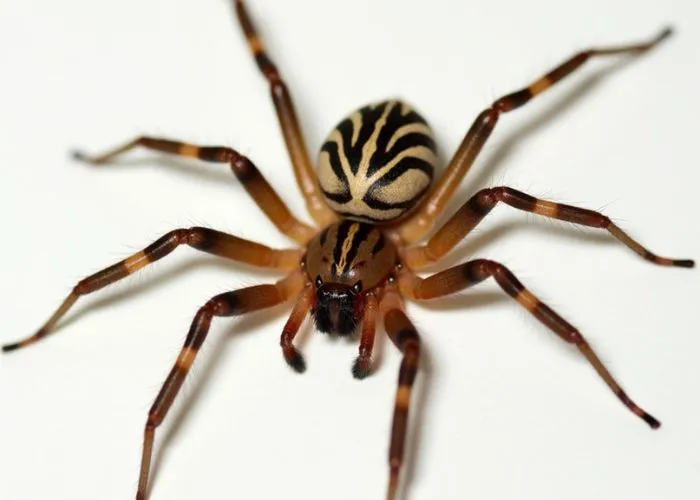What Do Hobo Spiders Look Like? Identifying Hobo Spiders in USA

Hobo spider (Tegenaria Agrestis) is medium-sized with a the body’s length of 1/3-1/2 inches (8-16 millimeters) and a length of that can reach 2 inches. The color can range from light brown to dark brown, having subtle herringbone or chevron designs in its abdominal. In contrast to brown recluses, hobo spiders don’t have the violin-shaped marking.
Hobo Spider vs. Giant House Spider
Giant house spiders as well as Hobo spiders reside within both the Pacific Northwest, but the giant house spider is bigger and not considered to be dangerous. The house spider of the giant size tends to be less likely to strike, and has longer legs.
Common Brown Spiders in Homes

A lot of brown spiders living at home are not harmful such as the common house spider or the cellar spider. If you are unsure you should seek assistance at a local extension office or a pest expert to identify the proper species.
Hobo Spider Behavior, Diet & Habits
Are Hobo Spiders Funnel Weavers?
Yes. Hobo spiders are funnel weaver who are known for making vertical, flat webs that have funnel-like retreat. The webs are normally located close to the ground in dark, uninhibited areas in both outside and inside American homes.
What Does a Hobo Spider Eat?
Hobo spiders eat small insects, such as beetles, ants, flies and many other arthropods. Their webs function as traps and also a base to entrap prey.
Hobo Spider Web Appearance
Hobo spider webs appear as a flat, dense sheet that has a funnel-shaped hole. This is the most important feature to identify hobo spiders in basements, crawl spaces garages, as well as outdoor sheds.
Where Do Hobo Spiders Live?
Habitat and Distribution
Hobo spiders occur most frequently throughout areas of the Pacific Northwest: Washington, Oregon, Idaho, western Montana as well as northern Utah. There are isolated cases in Colorado and Wyoming however they do not are seen in the eastern or southern parts of the USA.
Hobo Spider vs. Giant House Spider
They like dark, moist places near the ground. They are common in American residences, one can usually be able to find them in:
- Crawl spaces and basements
- Garages and sheds
- Wood piles and piles of debris
- Garden tools or landscape timbers
Their frequency of being inside grows in the latter part of summer and into early autumn as males seek out of their mates.
Are Hobo Spiders Dangerous? Hobo Spider Bite Symptoms
Do Hobo Spiders Bite?
Hobo spiders are able to bite when threatened or trapped, however they tend to be shy and avoid contact with humans. The majority of bites occur accidentally for instance, when handling items that are stored where spiders have a home.
Treatment for Hobo Spider Bites
If you suspect that you have a hobo-spider bite, wash it off with soap and clean water. Then then apply an ice compress and observe for any unusual signs. Most bites are not severe and cause minor swelling or redness. If you notice serious symptoms or you suspect an allergic reaction, you should seek medical treatment.
Are Hobo Spiders a Threat to Pets or Children?
Based on the CDC and studies conducted by Washington State University, the hobo spider (Tegenaria agrestis) is not a threat for healthy children, adults and pets living in USA. There have been reports of necrotic wounds that are often attributed on other types of spiders.
Brown Recluse in contrast to. Hobo Spider: Key distinctions
The brown recluse is a brown recluse. hobo spider conflation is a common issue on the web. Brown recluse spiders originate from in the Midwest and South and are not found in areas like the Pacific Northwest where hobo spiders are located. Brown recluses are distinguished by a violin-shaped marking and are considered to be more significant for medical reasons in comparison to the hobo spider, which does not have a distinct mark and their bites are usually not severe.
Life Cycle, Mating, and Special Behaviors of Hobo Spiders
Hobo spiders are a species with a year-long lifespan. They are born from eggs in spring, then mature in the summer and reproduce between late the fall and summer.
How Do Hobo Spiders Mate?
Males depart their webs seeking females typically returning to their homes in the latter part of summer. When they mat, females create eggs in the protected zones of their webs.
Special Behaviors and Defenses
Hobo spiders can run fast and depend on speed in order to avoid predators like birds, lizards, as well as larger spiders. They are more prone to fleeing than fighting and aren’t often hostile towards humans.
How Do I Get Rid of Hobo Spiders? Prevention and Treatment Tips
How to Help Prevent Hobo Spiders in Your Home
- Repair cracks in doors, foundations and windows.
- Reduce the clutter in storage spaces and basements
- Clear away debris and firewood from the foundation of your home.
- Keep crawl spaces and garages clean and well-ventilated.
- Set traps with sticky tape in likely hiding places
Signs of Spider Infestation
Find funnel-shaped webs in calm dark, secluded regions. An increase in spider sightings–especially in late summer–may signal a growing population.
DIY Vs. Professional Pest Control
While decluttering and cleaning can reduce the number of spiders in your home, ongoing infestations must be dealt with by experts like Orkin or an other licensed pest control company. Professionally applied treatments include specific applications and a skilled monitoring.
Conclusion:
Hobo Spider (Tegenaria Agrestis) is a well-established species found in the United States, especially the Pacific Northwest. Though often misunderstood by many, recent research has shown that it’s not a major threat to animals or humans. Through understanding its behavior and appearance, as well as effective methods to prevent it ensure that your home safe from spiders.
